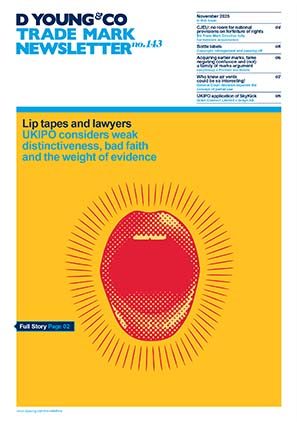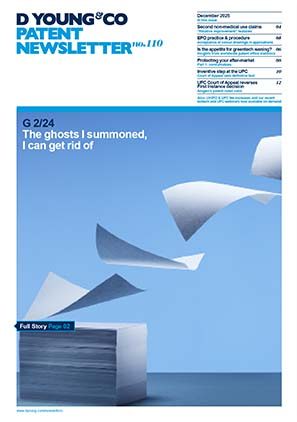Potential changes to the UK design system: September 2025 consultation
A review of the UK designs system is currently taking place, with the aim of providing a more effective and less complicated system that suits all kinds of businesses, from individual designers to large corporations. The majority of users of the designs system in the UK are microbusinesses, which can find the current design landscape difficult to navigate. Furthermore, there are issues with the validity of UK design registrations within the current system, as well as questions as to whether the current system adequately supports new forms of designs (such as virtual and animated designs) which are growing in popularity as technology develops.
A UK Government consultation was published in September 2025, and sets out proposals for addressing these issues within the current system. This consultation follows an initial call for views carried out in 2022 and a further survey published in February 2025 which sought the opinions of all users of the designs system in the UK.
This article discusses some of the main topics raised in the consultation, relating to the validity of registered designs, deferment of their publication, and the complexity of the current designs system in the UK more widely.
This consultation has the potential to cause significant changes to the UK designs system, so the aspiration is that all users of the UK designs system contribute and provide their opinion on the proposals, including legal professionals.
The consultation closes at 11:59 pm on 27 November 2025.
Improving validity of registered designs
Responses to the previous survey indicate that some UK design registrations are being applied for in bad faith: some applicants are filing applications for designs which they know are well-known and/or for designs which they do not own. These registrations are then being used to prevent legitimate trading. Currently, the burden is on third parties to invalidate a UK design registration: they must apply to invalidate the design registration and pay a fee, and may be prevented from trading while they wait for the result. Bad faith applications can therefore have a significant impact on small businesses. In order to address this problem, a range of proposals have been presented.
Search and examination
One proposal for addressing this issue is with the introduction of search and examination for UK design registrations.
There are three options relating to search and examination, which stakeholders are invited to comment upon.
- Do nothing and maintain the status quo.
- Provide a clear power in law for the UK design registry to investigate and object to designs which are suspected to be lacking in novelty and individual character. This option provides a balance between the need for searching to prevent bad faith applications, and the desire to maintain the speed and low-cost of the current designs system (which would be impacted by mandatory search and examination for all designs). A search would only be carried out in certain circumstances, and may be carried out using existing AI tools to maintain speed and low cost.
- Introduce a two-stage system, similar to the system currently used in Australia. Prospective UK design registrations would be registered without a search, but search and examination would be required to enforce the design registration. This option would better prevent the enforcement of bad faith applications and better prevent anti-competitive behaviours, however this would result in a significant change to the current application process.
Bad faith provisions
Another possibility for addressing this issue is through the addition of a bad faith provision. If implemented, the UK design registry would then be able to object during the examination process to designs which, in its opinion, have clearly been filed in bad faith.
Observation and opposition
Another proposal is to allow third parties to oppose the registration of a design, or file observations on its validity.
There are four options relating to opposition, which stakeholders are invited to comment upon.
- Do nothing and maintain the status quo.
- Introduce a post-registration opposition period for designs, which the consultation document proposes would be two months. This option would allow third parties to oppose anti-competitive registrations, however third parties would still have to wait for a decision, and may be prevented from doing business in the meantime. Thus, there is some consideration that this option does not resolve all of the issues with the current system.
- Introduce a pre-registration opposition period for designs, after examination is complete and before the design is registered. This would allow third parties to oppose anti-competitive filings before they are registered, preventing anti-competitive filings from halting legitimate business. However, third parties would need to monitor the register for conflicting rights, and would still need to pay a fee to oppose anti-competitive rights, thus the burden remains with third parties.
- Introduce a pre-registration observation period. A design would be published before registration, and third parties would have a period of time (two months) in which they could file observations. This option provides an additional way in which third parties can raise concerns about anti-competitive filings. The observations could then be used to object the anti-competitive filings during the examination process.
Deferment of publication
Publication of a UK design registration can be deferred so that the design is kept unpublished until its underlying content is disclosed through other channels (for example, as a result of the commercial launch of the underlying product to which the design registration relates). Under the current system, publication of a UK design registration can be deferred by up to 12 months from the date when the UK design registration is applied for.
There are differing opinions on how long the deferment period should be.
A balance must be struck between allowing applicants to keep their designs unpublished for commercial reasons, against the interest of third parties, who risk performing actions or making preparations for actions which would infringe a later-published UK design registration which they did not know existed.
The consultation document believes that the following provision provides the best balance between the interests of applicants and third parties:
- A deferment period with an 18 month duration;
- The deferment period starts from the earliest priority date of the application;
- Both registration, and full publication of the contents of the design registration, are deferred as a result of using deferred publication; and
- Prior to registration, basic information relating to the prospective design registration is published, such as the name of the applicant and the classification of the design in terms of its subject matter.
The consultation document has asked for opinion on each of these points in particular. Regarding the duration, the current deferment period of 12 month calculated from the date when the UK design registration is applied for, not its earliest priority date, minimises the legal risks for third parties, but may not be useful for applicants whose products have long development or launch cycles. A longer 30 month deferment period calculated from the earliest priority date of the design registration (as already allowed for by other design registries around the world, such as the European Union Intellectual Property Office (EUIPO) in the context of EU design registrations) supports products with long development or launch cycles. Introducing such a 30 month deferment period in the UK would therefore provide harmonisation with such other design registries around the world, however would increase the legal risk to third parties which may begin activities which infringe a later-published UK design registration. Therefore, the consultation document believes that an 18 month period calculated from the earliest priority date of the UK design registration provides a good balance for applicants and third parties.
Simplifying the designs system
Under the current system, designs can be protected under the following rights (depending on the design):
- UK registered designs
- International registered designs
- UK unregistered design right
- Supplementary unregistered designs (SUD)
- Copyright
There is therefore currently a number of different ways in which to protect designs, a number of which overlap each other. Consequently, it can be difficult for designers to understand which types of design rights are available for their design, and which options provide the best protection for their needs. The consultation document therefore proposes six options, three of which relate to potential changes to the unregistered designs framework, and three which relate to potential changes to copyright.
Changes to unregistered designs framework
- One option is to do nothing and maintain the status quo.
- The second option is to abolish UK unregistered design right and retain supplementary unregistered designs. This option provides simplification and harmonisation with the EU design protection system, and the appearance of the whole or part of a product would be protected for 3 years from first disclosure in the UK under SUDs. 2D and 3D designs would still be protected, as well as surface decoration. However, some aspects of designs would no longer be protected, such as purely functional aspects of shape and configuration, aspects of a complex product which are not visible in normal use, and the internal configuration of a product. Thus, although this option provides maximum simplification (as the scope of protection would be the same for registered and unregistered designs), some responders to the earlier call for views are concerned about the loss of protection for certain types of designs.
- Another option is to consolidate the unregistered designs framework, offering maximum protection. The framework could be consolidated in a number of ways. Consolidation may involve keeping two separate rights but harmonising certain provisions such as term and qualification requirements, or may involve creating a single consolidated right which has different legal provisions applying to the protection of the appearance of the design to the shape and configuration (for example, surface patterns must be visible during use, but shape/configuration do not). Consolidation may instead involve creating a fully consolidated right which protects both aesthetic and functional elements with the same legal provisions. This higher level of consolidation provides the most simplification, however limits the legal flexibility offered by the current system.
Disclosure of unregistered designs
A supplementary unregistered design (SUD) is the post-Brexit version of the unregistered Community design (UCD) right, and arises on “first disclosure of the design”. When the UK was part of the EU, this meant that designs disclosed anywhere in the EU would be protected by unregistered Community designs across the EU. However, it is currently unclear whether supplementary unregistered designs apply to designs first disclosed only in the UK, or across the EU. There is no mutual recognition of disclosure and therefore a single disclosure cannot technically give rise to protection across the UK and EU. Almost all responses to the consultation called for clarity in respect of disclosure for supplementary unregistered designs.
The UK design registry has discounted seeking reciprocal recognition of disclosure with the EU, or allowing any disclosure abroad to give rise to supplementary unregistered designs. However, it has identified five options to deal with these uncertainties.
- The first option is to do nothing and maintain the status quo.
- The second option is to unilaterally recognise simultaneous disclosure in law so that designs first disclosed simultaneously in the UK and in certain other territories (for example, a disclosure at a fashion show outside the UK which is live-streamed on the internet and available in the UK) would qualify for UK protection. This would simplify the system but would introduce asymmetry and would only benefit (and may encourage) disclosures outside of the UK.
- The third option is to introduce a grace period for unregistered designs. The disclosure of a design outside the UK could give rise to an supplementary unregistered design, if it is then subsequently disclosed or put on the market in the UK within a certain period of time. This may deal with some of the asymmetries but will add a layer of complexity to the regime.
- The fourth option is for a supplementary unregistered design to arise automatically following first disclosure anywhere in the EU (so long as it has come to the attention of the relevant trade circles in the UK). This differs from the second option in that it does not require simultaneous disclosure. This option reduces administrative burden but would result in asymmetry in that designs disclosed in the EU would benefit from protection in the UK when designs disclosed in the UK would not benefit from protection in the EU.
- The fifth option is for a supplementary unregistered design to arise automatically following first disclosure anywhere in the world (so long as it has come to the attention of the relevant trade circles in the UK). This option recognises that businesses operate globally and that large trade fairs often occur outside of the UK and EU. However, it would result in asymmetry in that designs disclosed in outside the UK would benefit from protection in the UK when designs disclosed in the UK would not necessarily benefit from protection in the rest of the world.
The UK design registry does not currently have a preferred option from the above.
Changes to copyright
Copyright protects original literary, dramatic, musical and artistic works, as well as films, sound recordings and broadcasts. This also includes graphic works, sculptures and works of artistic craftsmanship. There is an overlap in protection between copyright and designs for works of artistic craftsmanship, resulting in confusion for users as to whether a design is already protected by copyright.
There is currently an inconsistency between the UK and EU copyright regimes. Recent decisions from the Court of Justice of the European Union (CJEU) have held that copyright could subsist in any artistic work which was the intellectual creation of its author. In contrast, the UK regime provides for a closed list of works that attract copyright protection; meaning that there is less overlap between designs and copyright in the UK. Unless a design is a “work of artistic craftsmanship”, there is no copyright protection in the UK.
- An aspiration is to therefore ensure that the boundary between design rights and copyright in the UK is clear. However, recent UK case law has provided more certainty on what types of designs can be protected by copyright, such that one school of thought is that further clarity will develop through case law in the future. Thus, the first option, which is preferred by the consultation document, is to do nothing and allow further clarity to develop through case law.
- The second option relating to copyright is to update the legislation in the Copyright, Designs and Patents Act 1988 (CDPA) as to what can be protected by copyright. Specifically, the legislation could be updated to remove works of artistic craftsmanship from copyright protection, provide a definition of works of artistic craftsmanship, and/or provide a new definition of originality in relation to design articles. There is currently no definition of works of artistic craftsmanship nor originality in relation to designs in the CDPA, thus including definitions of these aspects would provide more clarity.
- The third option is to update the copyright exceptions framework. The activities which are protected by copyright and design rights are different. For example, copyright covers copying, distribution, and communication to the public, whereas design rights cover activities such as making, using selling, importing and exporting. There are exceptions provided in design law, such as activities relating to repair of a product, which do not exist under copyright law. Thus, copyright law can be more restrictive than design law for the same designs. Options to resolve this issue include reintroducing an exception for industrially manufactured items which provides a shorter term of copyright for items where more than a certain number are made, introducing a spare parts exception and harmonising this with the equivalent designs exception, and/or amending section 62 CDPA which would allow works for artistic craftsmanship to be represented in new artistic works such as photographs.
Other changes discussed in the consultation
In addition to the topics we have already discussed, the consultation provides proposals for changes in a range of other areas of the UK designs framework. The consultation also refers to changes relating to information provided on the existence of a right in a registered design, graphic user interfaces (GUIs) and animated designs, computer-generated designs, and other miscellaneous changes. The consultation also includes a call for evidence on the criminal sanctions for design infringement, and a call for evidence on the inclusion of claims made under the Registered Designs Act 1949 within the Intellectual Property Enterprise Court’s (IPEC) small claims track.
Useful link
UK Government UKIPO consultation on changes to the UK designs framework
Related article
Government consultation on possible reform to UK design law: have your say!



